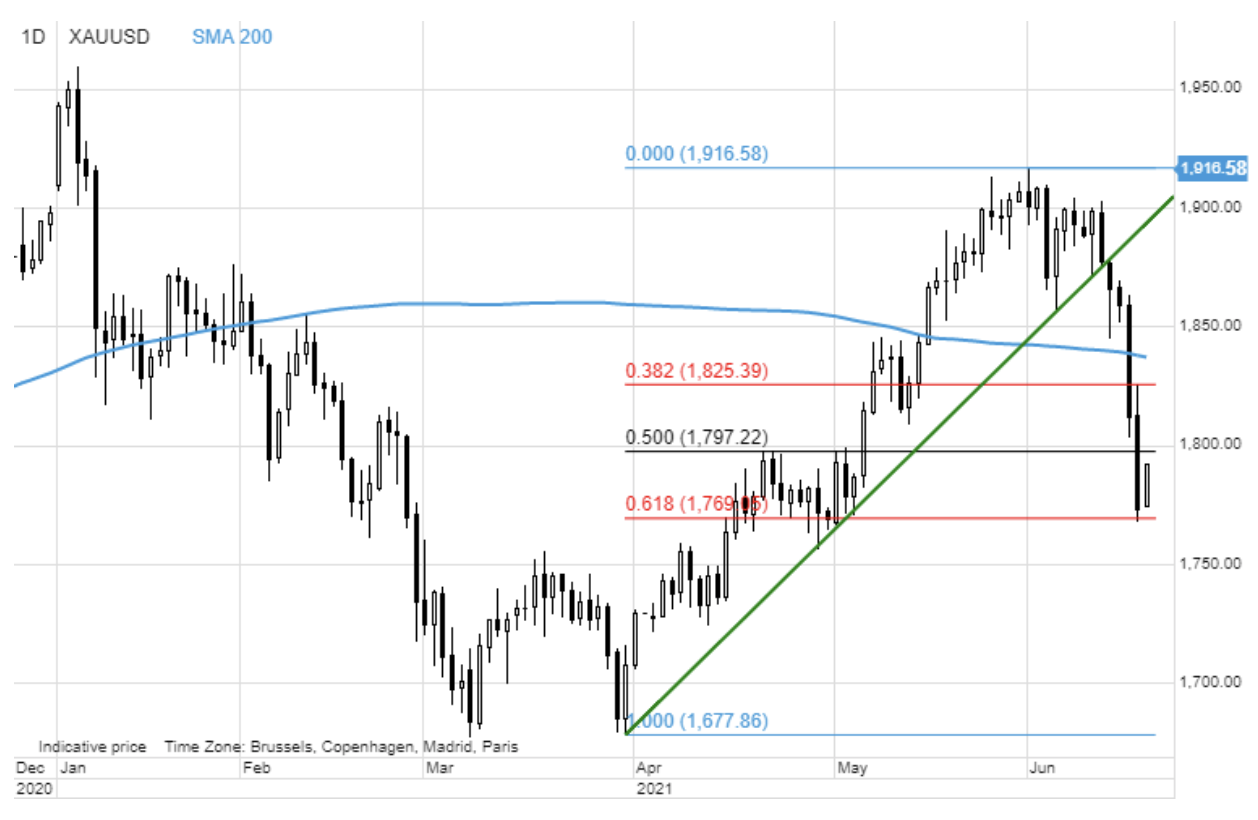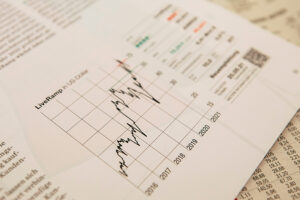Commodities depreciate after the FOMC slows down reflation transactions
The commodities sector has experienced one of its biggest weekly losses since the panic at the onset of the pandemic, when reflective trades lost momentum rapidly following FOMC signals that it intends to accelerate projected monetary tightening, thereby potentially reducing the risk of galloping inflation. This was overlapped by the actions of the Chinese authorities to lower inflation by limiting speculation and the mass purchase of raw materials. The problems were also caused by the stronger dollar, which reached its two-month high against a basket of other currencies.
About the Author
 Ole Hansen, head of department of commodity market strategy, Saxo Bank. Djoined a group Saxo Bank in 2008. Focuses on providing strategies and analyzes of global commodity markets identified by foundations, market sentiment and technical development. Hansen is the author of the weekly update of the situation on the goods market and also provides customers with opinions on trading goods under the #SaxoStrats brand. He regularly cooperates with both television and printed media, including CNBC, Bloomberg, Reuters, Wall Street Journal, Financial Times and Telegraph.
Ole Hansen, head of department of commodity market strategy, Saxo Bank. Djoined a group Saxo Bank in 2008. Focuses on providing strategies and analyzes of global commodity markets identified by foundations, market sentiment and technical development. Hansen is the author of the weekly update of the situation on the goods market and also provides customers with opinions on trading goods under the #SaxoStrats brand. He regularly cooperates with both television and printed media, including CNBC, Bloomberg, Reuters, Wall Street Journal, Financial Times and Telegraph.
The Federal Open Market Committee (FOMC) made a surprisingly large policy shift by deciding to take as many as two interest rate hikes by the end of 2023. This is a significant change from the March median forecast of no rate hikes until 2024. This suggests that many Fed members are uncomfortable with the magnitude of the recent rise in inflation. The core and headline inflation forecast for 2021 have been strongly revised upwards compared to the situation in March, while for next year the upward correction was only 0,1%, and the forecast for core inflation for 2023 has not been revised, which suggests the Fed continues to believe that the current inflationary pressures will prove to be temporary.
The market has "bought" the Fed's view of the transitional nature of inflation: ten-year yields above the break-even point, in other words, the projected rate of inflation growth, have gone down by 25 basis points. Combined with a stronger dollar, this hampered some important consensus-based transactions. Most of all, this concerned reflation transactions, which, together with solid fundamentals, contributed to a sharp rise in commodity prices over the last 6-9 months.
HG copper
The situation of industrial metals has been influenced by increased efforts by the Chinese authorities to contain price increases. They ordered state-owned companies to control risk and limit their exposure to foreign commodity markets, while the National Food and Strategic Reserves Agency confirmed recent rumors that it will soon begin releasing domestic reserves of copper, aluminum and zinc, which will be sold in batches to producers and producers. HG copper it has already suffered a loss from the recent loss of momentum, which has plunged its speculative long position to an annual low and, following signs of a weakening in its short-term fundamentals, it recorded an eight-week low.
Despite signals of a slowdown in Chinese demand, the copper bulls' hopes have not faded away in the long term. In fact, the market reaction last week highlights an important fact regarding markets and transactions. Strong gains usually start in response to over-selling in the market and / or new changes in fundamentals that can then self-propel themselves as speculative investors who are traded de facto indifferent, they continue to increase engagement until price action suggests them to hold and reverse orders.
The recent declines have not been the result of an unexpected lowering of expectations of market tightening in the coming years as supply inelasticity is struggling to meet the growing demand from the pressure on electrification; this was driven by investors limiting their exposure due to negative momentum and the FOMC-related pressure on copper as a hedge against inflation.
Precious metals
Gold i silver recorded significant corrections after FOMC signals that it intends to accelerate the predicted tightening of monetary policy. Markets were surprised by the scale of the Fed's policy adjustments, and yields on US government bonds rose sharply after the dollar appreciated. Despite a dynamic rebound in US Treasuries before the weekend, the technical price formation has already suffered losses and for both metals this may be the beginning of a longer period of looking for support and then consolidation.
Gold is still the commodity most sensitive to changes in interest rates and the dollar, and although the US currency reached its two-month high, changes in government bond yields worried the market the most. Despite admitting that inflation was going up, the Federal Reserve raised its projections for 2022 and 2023 by just 0,1% to 2,1% and 2,2%, respectively. The strong belief that inflation will be temporary contributed to a decline in ten-year yields above the break-even point by 25 basis points, and real yields after the original - harmful for gold - sharp increase ended the week with an increase of only 10 basis points (-0,81 %).
Gold, which did not see an increase in the volume of transactions in the days leading up to the FOMC meeting, fell due to the simultaneous strengthening of the dollar and an increase in yields. A drop below the two-hundred-day moving average at $ 1 opened the way to massive long surrender, while long-term funds began to rebuild their short. However, as the Relative Strength Index (RSI) begins to signal over-selling and thus a potential slowdown in capitulation sales, the area that needs to remain to avoid returning to the March lows is now in the range of $ 838-1. Relative security will only emerge after a move above $ 800 or, more importantly, the aforementioned two hundred day moving average of $ 1.
Agricultural commodities
The cereals market saw its strongest daily decline since 2009 after forecasts of favorable crop weather in parts of the US Midwest and global production spikes contributed to a deterioration in sentiment in the shortest-cycle commodities sector. What we mean here is the ability of the agricultural sector - weather permitting - to adjust the forecast supply from season to season from slight to significant.
Soybean futures, already negatively impacted by the prospect of a decline in biofuel demand from US refineries, recorded one of the largest daily losses in history. At the same time, maize was losing more than 12% weekly, before news of May's fivefold increase in maize imports in China calmed the price action somewhat ahead of the weekend.
The market is highly dependent on weather conditions and, like metals, which experience deterioration in foundations, internal foundations, such as better crop forecasts, do not warrant a similar scale correction. The market focuses instead on financial investors, many of whom have been surprised by the unexpected shift in policy regarding rates and inflation signaled by the Federal Reserve. Once the dust settles after this phase of long consolidation, just another shift in the short-term weather forecast may suffice for an upward reversal.
Petroleum
In the context of the punctual decline in the metals and agricultural products sectors ahead of the FOMC meeting, Petroleum it increasingly seemed to be a winner, supported by rising demand and OPEC + supply constraints. However, the chaos among commodity bulls after the FOMC meeting also managed to cause a relatively slight increase in oil sales.
Until then, buy orders prevailed among speculative investors as they believed that downside risk was limited given that OPEC + maintains supply constraints while increasing demand. According to the IEA, such an increase may bring demand back to pre-pandemic levels by the end of next year. Another weekly decline in US oil stocks failed to bolster prices; gasoline and diesel stocks rose at the same time.
Aside from the weakening following the FOMC meeting, price was supported by forecasts by major global commodity traders at the FT Global Commodity Summit assuming that oil prices could return to $ 100 in the coming years as new supply investments hold back and major producers diversify capital expenditures in towards renewable energies at the expense of oil and gas. This highlights a potential dilemma: politicians and investors want a faster transition to renewable energies than is currently possible. This means the risk of a shortage of supply before demand begins to slow down in the second half of this decade.
However, it is clear that OPEC + is in strong control of prices, while global demand continues to recover. This situation will continue at least until producers outside OPEC + respond to the increase in revenues and profitability by increasing production. Production decisions will be taken at the meeting in early July; These will be crucial as it will send a clear signal as to whether the Saudi-led group will seek to increase prices by artificially keeping supply low, or whether its priority will be to stabilize by increasing production.






















![Forex Club – Tax 9 – Settle tax on a foreign broker [Download the Application] Forex Club - Tax 9](https://forexclub.pl/wp-content/uploads/2024/02/Forex-Club-Podatek-9-184x120.jpg?v=1709046278)
![Trading View platform – solutions tailored to the needs of traders [Review] trading view review](https://forexclub.pl/wp-content/uploads/2024/03/trading-view-recenzja-184x120.jpg?v=1709558918)
![How to connect your FP Markets account to the Trading View platform [Guide] fp markets trading view](https://forexclub.pl/wp-content/uploads/2024/02/fp-markets-trading-view-184x120.jpg?v=1708677291)
![CRB index – one of the popular commodity market benchmarks [Guide] crb index](https://forexclub.pl/wp-content/uploads/2024/05/indeks-crb-184x120.jpg?v=1715055656)
![How to invest in ChatGPT and AI? Stocks and ETFs [Guide] how to invest in chatgpt and artificial intelligence](https://forexclub.pl/wp-content/uploads/2023/02/jak-inwestowac-w-chatgpt-i-sztuczna-inteligencje-184x120.jpg?v=1676364263)







![Izabela Górecka – “Success on the market depends not only on knowledge, but also on emotional stability” [Interview] Izabela Górecka - interview](https://forexclub.pl/wp-content/uploads/2024/04/Izabela-Gorecka-wywiad-184x120.jpg?v=1713870578)
![WeWork – the anatomy of the collapse of a company valued at $47 billion [WeWork, part II] wework bankruptcy story](https://forexclub.pl/wp-content/uploads/2024/04/wework-bankructwo-historia-184x120.jpg?v=1711729561)
![Adam Neumann – the man who screwed up Softbank [WeWork, part AND] adam neumann wework](https://forexclub.pl/wp-content/uploads/2024/04/adam-neumann-wework-184x120.jpg?v=1711728724)
![The most common mistakes of a beginner trader - Mr Yogi [VIDEO] Scalping - The most common mistakes of a beginner trader - VIDEO](https://forexclub.pl/wp-content/uploads/2024/03/Scalping-Najczestsze-bledy-poczatkujacego-tradera-VIDEO-184x120.jpg?v=1711601376)
![Learning patience: No position is also a position - Mr Yogi [VIDEO] Scalping - Learning patience - No position is also a position - VIDEO](https://forexclub.pl/wp-content/uploads/2024/03/Scalping-Nauka-cierpliwosci-Brak-pozycji-to-tez-pozycja-VIDEO-184x120.jpg?v=1710999249)
![When to exit a position and how to minimize losses - Mr Yogi [VIDEO] Scalping - When to exit a position and how to minimize losses - VIDEO](https://forexclub.pl/wp-content/uploads/2024/03/Scalping-Kiedy-wyjsc-z-pozycji-i-jak-minimalizowac-straty-VIDEO-184x120.jpg?v=1710336731)







![CRB index – one of the popular commodity market benchmarks [Guide] crb index](https://forexclub.pl/wp-content/uploads/2024/05/indeks-crb-300x200.jpg?v=1715055656)














Leave a Response